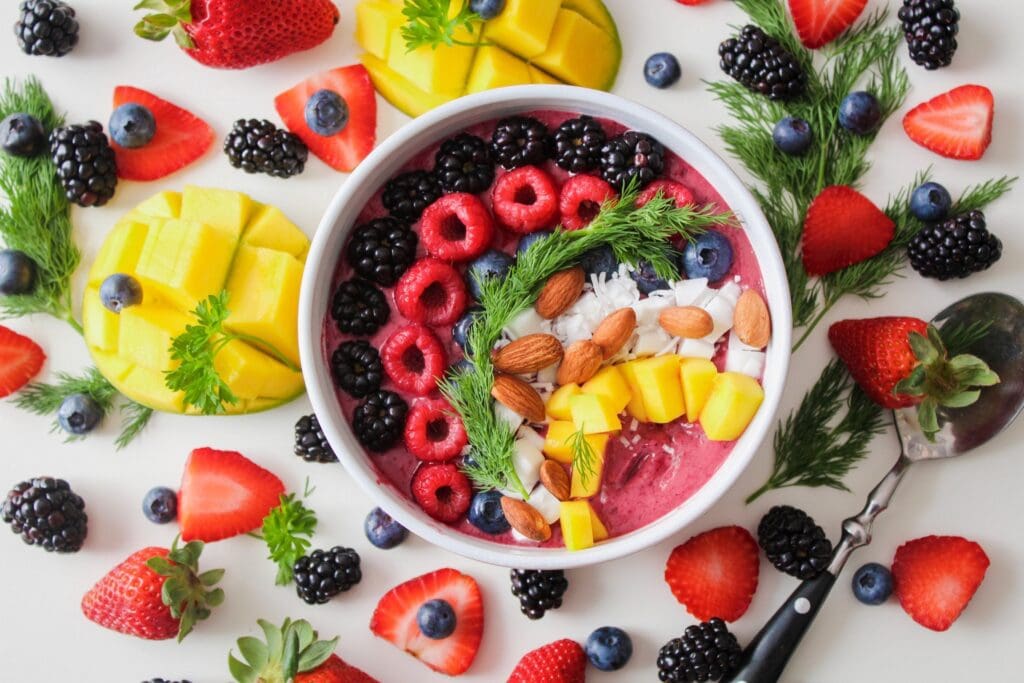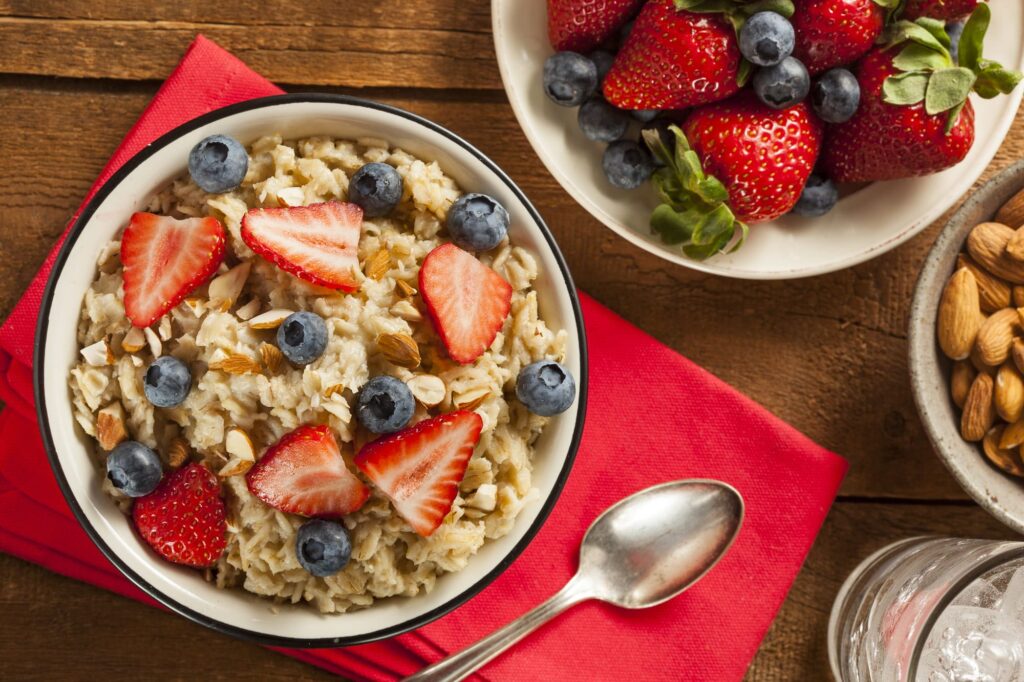Breakfast has long been hailed as the most important meal of the day, and for good reason. It kickstarts your metabolism, replenishes your energy levels, and sets the tone for your eating habits throughout the day.

For individuals looking to shed excess body fat, a well-balanced breakfast is a crucial component of their fat loss plan.
Skipping breakfast may seem like a shortcut to cutting calories, but it often leads to overcompensating with unhealthy food choices later in the day. Moreover, a morning meal provides the nutrients your body needs to function optimally, ensuring you’re physically and mentally prepared to tackle your daily activities and workouts.
In the context of a fat loss plan, breakfast serves several important purposes. It jumpstarts your metabolism, enabling your body to burn calories more efficiently. It also helps stabilize blood sugar levels, reducing the likelihood of energy crashes and cravings for sugary, high-calorie snacks. By choosing the right foods for breakfast, you can support your fat loss goals without feeling deprived or hungry.
The Role of Low Fat Breakfasts
While the composition of a breakfast can vary widely, opting for a low-fat breakfast can be particularly advantageous for those seeking quicker fat loss. Low-fat breakfasts provide a balanced combination of macronutrients, including carbohydrates, protein, and healthy fats, without the excess saturated fats that can contribute to weight gain.

Reducing fat intake in the morning can be a strategic move, as the body’s ability to process dietary fat is generally higher later in the day. By consuming a low-fat breakfast, you can ensure that the calories you ingest are more likely to be utilized as immediate energy rather than stored as fat.
5 Best Lazy Abs Exercises to Shrink Your Belly
Start Doing the Reverse Crunch – An Effective Ab Exercise to Get A Six-Pack
Beginner’s Guide to A Six-Pack – Eating and Training Tips
10 HIIT Exercises to Lose Belly Fat Faster
9 Most Effective Abs Exercises You Have Never Done
In this article, we’ll explore three delightful low-fat breakfast options that not only promote fat loss but also satisfy your taste buds. These options are carefully crafted to provide the essential nutrients your body needs to function optimally without compromising on flavor or variety.
By incorporating these nutritious breakfasts into your daily routine, you can kickstart your fat loss journey while enjoying a variety of flavors and textures. So, let’s dive in and discover how these low-fat breakfast options can contribute to quicker fat loss without sacrificing taste or nutrition.
Option 1: Greek Yogurt Parfait
Ingredients
To prepare a delicious and nutritious Greek Yogurt Parfait, you’ll need the following ingredients:

For the Base:
- 1 cup of plain Greek yogurt (low-fat or non-fat)
- 1 tablespoon of honey or maple syrup (optional, for sweetness)
- 1/2 teaspoon of vanilla extract (optional, for flavor)
For the Layers:
- 1/2 cup of fresh mixed berries (strawberries, blueberries, raspberries)
- 1/4 cup of granola (choose a low-fat, low-sugar variety)
- 1 tablespoon of chopped nuts (e.g., almonds, walnuts) for added texture and healthy fats
Preparation
Prepare the Base:
In a mixing bowl, combine the Greek yogurt, honey or maple syrup (if using), and vanilla extract (if using). Stir until well incorporated. This will be the creamy base of your parfait.
Layer the Ingredients:
Take a clear glass or parfait dish and start by adding a spoonful of the Greek yogurt mixture as the first layer.
Follow with a layer of mixed berries, spreading them evenly over the yogurt.
Sprinkle a portion of the granola on top of the berries, adding a delightful crunch.
Repeat these layers until you’ve used up all the ingredients or reached your desired serving size.
Finish and Serve:
Top your parfait with a final dollop of Greek yogurt and a sprinkle of chopped nuts for added texture and healthy fats.
Nutritional Benefits
Greek Yogurt Parfait is a nutrient-packed breakfast choice that offers several health benefits:
Protein: Greek yogurt is rich in protein, which helps keep you feeling full and satisfied throughout the morning. It also supports muscle maintenance and growth.
Probiotics: Greek yogurt contains beneficial probiotics that promote gut health and aid in digestion.
Fiber: Berries and granola contribute dietary fiber, which supports digestive health and helps control hunger.
Antioxidants: Berries are packed with antioxidants, such as vitamins C and A, which help combat oxidative stress and support overall health.
Low Fat: By opting for low-fat or non-fat Greek yogurt and choosing a low-fat granola, you keep the fat content of this breakfast option in check, making it suitable for a fat loss plan.
Tips for Customization
Customizing your Greek Yogurt Parfait allows you to tailor it to your taste and dietary preferences:
Fruit Variations: Experiment with different fruits like sliced bananas, kiwi, or mango for a variety of flavors and textures.
Nut Selection: Feel free to use your favorite nuts, such as pecans or cashews, for added crunch and flavor.
Sweeteners: Adjust the sweetness to your liking by using more or less honey or maple syrup, or even opting for a sugar-free alternative like stevia.
Dairy-Free Option: If you’re lactose intolerant or prefer a dairy-free option, use almond yogurt or coconut yogurt instead of Greek yogurt.
Why It Supports Fat Loss
Greek Yogurt Parfait is an excellent choice for those seeking fat loss for several reasons:
Protein and Satiety: The high protein content in Greek yogurt helps keep you full, reducing the likelihood of overeating later in the day.
Balanced Nutrition: This parfait provides a balanced mix of carbohydrates, protein, and fiber, keeping your energy levels stable and reducing cravings for unhealthy snacks.
Low Fat: By choosing low-fat or non-fat Greek yogurt and a low-fat granola, you keep your fat intake in check while still enjoying a satisfying and delicious breakfast.
Nutrient Density: The inclusion of fresh berries adds essential vitamins, minerals, and antioxidants without excess calories, contributing to overall health and well-being.
Enjoying a Greek Yogurt Parfait as part of your fat loss plan not only supports your nutritional goals but also tantalizes your taste buds with its creamy, fruity goodness.
Option 2: Veggie Omelette
Ingredients
To prepare a nutritious and satisfying Veggie Omelette, gather the following ingredients:
 Source: Engin Aykurt on Pexels
Source: Engin Aykurt on PexelsFor the Omelette:
- 2 large eggs
- 1/4 cup diced bell peppers (a mix of red, green, or yellow for color)
- 1/4 cup diced onions
- 1/4 cup diced tomatoes
- 1/4 cup sliced mushrooms
- 1/4 cup baby spinach leaves
- Salt and pepper to taste
- Cooking spray or a small amount of olive oil for the pan
Optional Additions:
1/4 cup low-fat cheese (such as feta or shredded cheddar)
A pinch of dried herbs (e.g., oregano, basil, or thyme)
Preparation
Prepare the Vegetables:
- Heat a non-stick skillet over medium heat and lightly coat it with cooking spray or a small amount of olive oil.
- Add the diced bell peppers, onions, and mushrooms to the skillet. Sauté them until they become tender, which should take about 2-3 minutes.
- Stir in the diced tomatoes and baby spinach leaves, and continue to cook for an additional 1-2 minutes until the spinach wilts.
Whisk the Eggs:
While the vegetables are cooking, crack the eggs into a bowl, and whisk them until well beaten. Season with a pinch of salt and pepper to taste.
Cook the Omelette:
Once the vegetables are tender, spread them evenly across the skillet.
Pour the beaten eggs over the vegetables, ensuring they cover the entire surface of the skillet.
Allow the eggs to cook undisturbed for a few minutes until they start to set.
Add Cheese (Optional):
If you’re including cheese, sprinkle it evenly over one-half of the omelette.
Fold and Serve:
Carefully fold the omelette in half to cover the side with cheese (if added). Press down gently with a spatula to help it hold its shape.
Serve Hot:
Slide the omelette onto a plate, and garnish with a pinch of dried herbs, if desired. Serve hot.
Nutritional Benefits
A Veggie Omelette offers a wide range of nutritional benefits, making it an excellent choice for those aiming for fat loss:
Protein: Eggs are rich in high-quality protein, which helps control hunger and supports muscle maintenance and growth.
Low in Calories: Omelettes are relatively low in calories, making them a filling and nutritious choice for a calorie-restricted diet.
Fiber: The vegetables in this omelette provide dietary fiber, aiding digestion and promoting satiety.
Vitamins and Minerals: Bell peppers, tomatoes, and spinach contribute essential vitamins and minerals such as vitamin C, vitamin A, and folate, which are important for overall health.
Low Fat: By using cooking spray or a small amount of olive oil and incorporating low-fat cheese sparingly (or omitting it), you can keep the fat content of your omelette under control.
Tips for Flavor Variations
Customize your Veggie Omelette to suit your taste preferences and dietary needs:
Protein Boost: Add lean proteins like diced turkey or chicken breast for an extra protein punch.
Spice It Up: Incorporate a dash of hot sauce, red pepper flakes, or your favorite herbs and spices for added flavor.
 Source: Courtesy of CrossFit Inc.
Source: Courtesy of CrossFit Inc.Dairy Choices: Experiment with different cheeses such as goat cheese, mozzarella, or a dairy-free alternative for varied flavors.
Vegetable Variety: Swap out or add vegetables like zucchini, broccoli, or asparagus for diversity in taste and nutrition.
Why It Supports Fat Loss
The Veggie Omelette is a stellar choice for individuals seeking fat loss due to several key reasons:
High Protein: Eggs are a great source of protein, which helps control appetite, reduce snacking, and preserve lean muscle mass during calorie restriction.
Low-Calorie Option: Omelettes are relatively low in calories, allowing you to enjoy a substantial meal while staying within your calorie limits.
Fiber and Satiety: The inclusion of vegetables provides fiber, promoting fullness and reducing the desire for high-calorie, unhealthy snacks.
Balanced Nutrition: This breakfast offers a balance of protein, healthy fats (if used sparingly), and carbohydrates from vegetables, ensuring sustained energy and satisfaction.
Customizable: You can tailor your Veggie Omelette to suit your taste, making it a versatile and enjoyable option for your fat loss plan.
Incorporating a Veggie Omelette into your breakfast routine not only supports your fat loss goals but also provides a delicious and nutritious way to start your day.
Option 3: Oatmeal with Berries
 Source: bhofack2
Source: bhofack2Ingredients
To prepare a wholesome and satisfying Oatmeal with Berries, gather the following ingredients:
For the Oatmeal:
- 1/2 cup of old-fashioned rolled oats
- 1 cup of water or milk (dairy or plant-based)
- 1/4 teaspoon of salt
- 1/2 teaspoon of vanilla extract (optional)
- 1/4 teaspoon of ground cinnamon (optional)
For the Toppings:
- 1/2 cup of fresh mixed berries (e.g., strawberries, blueberries, raspberries)
- 1 tablespoon of chopped nuts (e.g., almonds, walnuts)
- 1 teaspoon of honey or maple syrup (optional, for sweetness)
Preparation
Cook the Oatmeal:
In a saucepan, bring the water or milk to a boil over medium-high heat.
Stir in the rolled oats, salt, vanilla extract (if using), and ground cinnamon (if using). Reduce the heat to low and simmer for about 5-7 minutes, stirring occasionally, until the oats are soft and the mixture thickens to your desired consistency.
Serve the Oatmeal:
Once the oatmeal is ready, transfer it to a bowl.
Add the Toppings:
Top your oatmeal with fresh mixed berries, chopped nuts, and a drizzle of honey or maple syrup if you prefer a touch of sweetness.
Stir and Enjoy:
Gently stir the toppings into the oatmeal to combine all the flavors.
Nutritional Benefits
Oatmeal with Berries offers a wealth of nutritional benefits, making it a superb choice for those aiming for fat loss:
Fiber: Oats are rich in soluble fiber, which helps regulate blood sugar levels, reduce cholesterol, and promote feelings of fullness.
Antioxidants: Berries are packed with antioxidants, such as anthocyanins, which help combat oxidative stress and support overall health.
Protein: Rolled oats provide a modest amount of protein, contributing to feelings of satiety and muscle maintenance.
Low in Calories: Oatmeal is relatively low in calories, making it an ideal choice for those watching their calorie intake.
Heart-Healthy: The combination of oats, berries, and nuts provides heart-healthy fats and nutrients that support cardiovascular well-being.
Tips for Enhancing Flavor
Personalize your Oatmeal with Berries to suit your taste preferences and add variety:
Nut Butter: Swirl in a tablespoon of almond butter, peanut butter, or cashew butter for added creaminess and flavor.
Spices: Experiment with spices like nutmeg, cardamom, or ginger to add warmth and depth to your oatmeal.

Sweeteners: Use alternative sweeteners like stevia, agave nectar, or date syrup for a healthier option.
Dried Fruit: Add a handful of chopped dried fruit such as raisins, cranberries, or apricots for a chewy texture and natural sweetness.
Why It Supports Fat Loss
Oatmeal with Berries is an excellent choice for individuals seeking fat loss due to the following reasons:
Satiety: Oats are rich in soluble fiber, which promotes feelings of fullness and reduces the likelihood of overeating later in the day.
Steady Energy: Oatmeal provides complex carbohydrates that are digested slowly, offering sustained energy throughout the morning and helping to control cravings.
Nutrient Density: The inclusion of berries adds essential vitamins, minerals, and antioxidants without excess calories, promoting overall health and well-being.
Low-Calorie Option: Oatmeal is relatively low in calories, allowing you to enjoy a filling breakfast while adhering to a calorie-restricted diet.
Customizable: You can tailor your Oatmeal with Berries to suit your taste, making it a versatile and enjoyable option for your fat loss plan.
Incorporating a bowl of Oatmeal with Berries into your morning routine not only supports your fat loss goals but also provides a comforting and nutritious way to start your day.
The Science Behind Low Fat Breakfasts and Fat Loss
The composition of your breakfast can have a significant impact on your metabolism. Low-fat breakfasts play a vital role in supporting efficient metabolic function.
Here’s how:
Efficient Energy Utilization: Low-fat breakfasts provide a source of immediate energy, as they are typically lower in calories from fat. This means your body can utilize the calories consumed for energy rather than storing them as fat.
Thermic Effect of Food (TEF): Low-fat foods tend to have a higher thermic effect of food, meaning they require more energy to digest and metabolize. This can temporarily increase your metabolic rate, leading to more calories burned during digestion.
Improved Fat Oxidation: Low-fat breakfasts encourage your body to tap into stored fat for energy, especially when combined with physical activity. This can aid in fat loss over time.
Satiety and Reduced Caloric Intake
One of the critical factors in successful fat loss is controlling calorie intake, and low-fat breakfasts contribute to this by promoting satiety:
Volume and Fullness: Low-fat breakfasts are often voluminous, allowing you to eat a larger quantity of food without consuming excessive calories. This can create a sense of fullness and satisfaction.
Protein Content: Many low-fat breakfast options, such as Greek yogurt and egg-based dishes, are rich in protein. Protein has a pronounced effect on satiety, helping to reduce overall calorie intake by curbing hunger and reducing the desire to snack.
Steady Blood Sugar Levels: Low-fat breakfasts with complex carbohydrates and protein help stabilize blood sugar levels, preventing rapid spikes and crashes that can lead to increased hunger and overeating later in the day.
Blood Sugar Control and Fat Storage
Balancing blood sugar levels is crucial for fat loss, and low-fat breakfasts can play a role in achieving this balance:
Carbohydrate Quality: Low-fat breakfasts often include complex carbohydrates like oats or whole grains. These carbohydrates are digested slowly, leading to a gradual release of glucose into the bloodstream, preventing sharp spikes in blood sugar.
Insulin Sensitivity: Maintaining lower levels of dietary fat in the morning can improve insulin sensitivity. When your body responds well to insulin, it is less likely to store excess glucose as fat, contributing to fat loss.
Studies and Research Findings
Scientific studies have explored the relationship between low-fat breakfasts and fat loss:
A Study in the American Journal of Clinical Nutrition (2008): This study found that participants who consumed a low-fat breakfast experienced reduced hunger and calorie intake throughout the day compared to those who ate a high-fat breakfast.
Research Published in the International Journal of Obesity (2015): This study demonstrated that individuals who included low-fat dairy products in their breakfasts had improved body composition and reduced overall fat mass compared to those who consumed high-fat dairy products.
A Study in the Journal of Nutrition (2009): Research in this study indicated that a low-fat, high-protein breakfast led to greater fat loss and improved waist circumference compared to a high-carbohydrate, high-fat breakfast.
These findings suggest that incorporating low-fat breakfasts into your daily routine can positively impact metabolism, satiety, blood sugar control, and ultimately, fat loss. However, it’s essential to consider individual dietary preferences and consult with a healthcare professional or registered dietitian when planning a fat loss strategy to ensure it aligns with your specific needs and goals.
Practical Tips for Incorporating Low Fat Breakfasts into Your Routine
When it comes to integrating low-fat breakfasts into your daily routine, effective meal planning and preparation are key:
- Plan Ahead: Set aside time to plan your breakfasts for the week. Create a menu that includes a variety of low-fat options to keep your mornings interesting.
- Prep Ingredients: Wash, chop, and portion out ingredients in advance, such as fruits, vegetables, and grains. This makes it easier to put together your breakfast quickly, even on busy mornings.
- Batch Cooking: Prepare larger quantities of certain components, like oatmeal or egg whites, in advance. Store them in portion-sized containers for a grab-and-go breakfast option.
- Cook in Bulk: Make larger batches of low-fat breakfast items like omelettes or yogurt parfaits and store leftovers in the fridge for the next day or two.
Portion Control
Controlling portion sizes is crucial for managing calorie intake, even with low-fat breakfasts:
- Use Measuring Tools: Invest in measuring cups and kitchen scales to accurately portion out ingredients and prevent overeating.
- Read Labels: Pay attention to serving sizes on food labels, especially for items like granola or yogurt, which can be calorie-dense if not portioned properly.
- Practice Mindful Eating: Take your time to savor each bite, and pay attention to your body’s hunger cues. Eating slowly can help you recognize when you’re satisfied and avoid overeating.
Combining Low Fat Breakfasts with Other Nutritious Choices
Enhance the nutritional value of your low-fat breakfasts by incorporating other healthy elements:
Add Fresh Produce: Include a side of fresh fruits or vegetables with your low-fat breakfast to boost the fiber and nutrient content.
Hydration: Start your day with a glass of water or herbal tea to hydrate your body and help control appetite.
Lean Proteins: Consider adding a small serving of lean protein like turkey bacon, lean ham, or tofu to your breakfast for extra satiety.
Healthy Fats: While the focus is on low-fat options, incorporating a small amount of healthy fats like avocado or a drizzle of olive oil can enhance the flavor and nutritional profile of your breakfast.
Staying Consistent
Consistency is key when it comes to incorporating low-fat breakfasts into your routine:
Create a Schedule: Establish a regular breakfast schedule and stick to it as closely as possible, even on weekends. Consistency can help regulate your metabolism and prevent overindulgence later in the day.
Variety is Key: Keep your breakfasts interesting by rotating between different low-fat options. This prevents boredom and ensures you receive a wide range of nutrients.
Allow for Treats: While low-fat breakfasts are essential for fat loss, it’s okay to indulge occasionally. Just be mindful of portion sizes and frequency when including higher-fat breakfast choices.
Track Progress: Keep a food diary or use a tracking app to monitor your breakfast choices and how they align with your fat loss goals. Tracking can help you stay accountable and make adjustments as needed.
Incorporating these practical tips into your routine can make it easier to adopt and maintain a habit of eating low-fat breakfasts as part of your fat loss strategy. Remember that fat loss is a gradual process, and consistency over time is key to achieving and maintaining your desired results.
Conclusion
In this article, we explored three delicious and nutritious low-fat breakfast options that can support your fat loss goals:
Greek Yogurt Parfait: A creamy and protein-packed delight that combines Greek yogurt with fresh fruits and granola, offering a balanced and satisfying start to your day.
Veggie Omelette: A savory, protein-rich breakfast featuring a mix of vegetables that not only keeps you full but also provides a range of essential nutrients.
Oatmeal with Berries: A wholesome bowl of oatmeal topped with antioxidant-rich berries, offering sustained energy, fiber, and a host of health benefits.
The Key to Successful Fat Loss
While incorporating low-fat breakfasts into your routine can be a valuable component of your fat loss plan, it’s important to remember that successful fat loss involves a holistic approach. The key factors for achieving and maintaining fat loss include:
Balanced Diet: Focus on a well-rounded diet that includes a variety of nutrients and food groups. Maintain a calorie deficit to encourage fat loss, but ensure you meet your nutritional needs.
Regular Physical Activity: Incorporate regular exercise into your routine, including both cardiovascular and strength training exercises. Physical activity helps burn calories, preserve muscle mass, and support fat loss.
Adequate Hydration: Drink plenty of water throughout the day to stay hydrated, support metabolic processes, and help control appetite.
Sleep and Stress Management: Prioritize quality sleep and manage stress effectively, as both factors can impact hormone levels and appetite regulation.
Consistency: Stick to your fat loss plan consistently over time. Gradual, sustainable changes are more likely to lead to long-term success.
Start Your Day Right with Low Fat Breakfasts for a Healthier You!
Beginning your day with a nutritious low-fat breakfast sets a positive tone for the hours ahead. These breakfast options offer a blend of flavors, textures, and nutrients that not only support fat loss but also cater to your taste preferences.
As you embark on your journey toward a healthier you, remember that fat loss is a gradual process that requires commitment and patience. By making informed choices about your breakfast and adopting a holistic approach to your lifestyle, you can achieve your fat loss goals while enjoying satisfying, delicious, and low-fat breakfasts that nourish both your body and your spirit. Here’s to a healthier, happier you!

:max_bytes(150000):strip_icc()/GettyImages-1452718425-6d3056c680f04a6093f258fc829e0acb.jpg)
